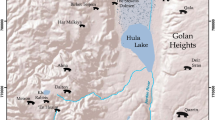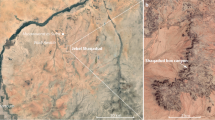Abstract
Seen by all who visit Wonderwerk Cave, the rock paintings that adorn its walls have attracted less attention than many other aspects of the site. The paper gives a brief account of their history and significance and of factors that have constrained their study. Graffiti damage and restoration added layers through which researchers would need to delve in order to understand them archaeologically. Pointing to directions for future work, the paper concludes with discussion on a currently debated category of southern African rock art, the “non-entoptic” geometric rock art tradition, to which the Wonderwerk Cave rock paintings would belong. A shift in theoretical focus is advocated for comprehending local contingencies in the formation of rock art “traditions” rather than simply assuming the prior existence of such constructs.
Résumé
Vues par tous les visiteurs de la caverne Wonderwerk, les peintures qui ornent ses murs ont attiré moins d’attention que d’autres aspects du site. Cet article donne un bref compte rendu de leur histoire et leur sens, ainsi que des facteurs qui ont limité leur étude. Le vandalisme et les restaurations ont ajouté des couches à travers lesquelles les chercheurs auront besoin de fouiller afin de les comprendre d’un point de vue archéologique. Suggérant des directions pour de futurs travaux, cet article se conclut par une discussion sur une catégorie d’art pariétal sud-africain actuellement débattue, la tradition d’art géométrique ‘non-entoptique’, à laquelle les peintures de la caverne Wonderwerk appartiendraient. Un changement d’orientation théorique est prôné afin de comprendre les contingences locales dans la formation des ‘traditions’ d’art pariétal, au lieu de présupposer l’existence de tels constructions.









Similar content being viewed by others
References
Bassett, S. T. (2004). A review of graffiti removal techniques at Wonderwerk Cavee 11 years after intervention. Unpublished report.
Bassett, S. T., & Deacon, J. (1993). Report on the removal of graffiti at Wonderwerk Cave. Unpublished report to the National Monuments Council.
Beaumont, P. B., & Vogel, J. C. (2006). On a timescale for the past million years of human history in central South Africa. South African Journal of Science, 102, 217–228.
Bonneau, A., Pearce, D. G., & Pollard, A. M. (2012). A multi-technique characterization and provenance study of the pigments used in San rock art, South Africa. Journal of Archaeological Science, 39, 287–294.
Chazan, M., & Horwitz, L. K. (2009). Milestones in the development of symbolic behaviour: A case study from Wonderwerk cave, South Africa. World Archaeology, 41, 521–539.
Chazan, M., & Horwitz, L. K. (2015). An overview of recent research at Wonderwerk Cave, South Africa. Proceedings of the 2010 joint meeting of the Panafrican Archaeological Congress and the Society of Africanist Archaeologists, Dakar, Senegal (pp. 253-260).
Chazan, M., Ron, H., Matmon, A., Porat, N., Goldberg, P., Yates, R., et al. (2008). First radiometric dates for the earlier stone age sequence in Wonderwerk Cave, South Africa. Journal of Human Evolution, 55, 1–11.
Chippindale, C. (2004). Comment on “Taking stock: Identifying Khoekhoen herder rock art in Southern Africa. Current Anthropology, 45, 515–516.
Eastwood, E. B. (2003). A cross-cultural motif in San, Khoekhoe and Northern Sotho rock paintings of the Central Limpopo Basin, southern Africa. South African Archaeological Bulletin, 58, 14–26.
Eastwood, E. B., & Smith, B. W. (2005). Fingerprints of the Khoekhoen: Geometric and handprinted rock art of the Central Limpopo Basin, southern Africa. South African Archaeological Society Goodwin Series, 9, 63–76.
Ego, R. (2001). A pictorial device: The dynamic action of water in a few depictions of rain animals. Pictogram, 12, 23–28.
Elphick, R. (1985). Khoikhoi and the founding of White South Africa. Johannesburg: Ravan Press.
Fock, G. J. (1969). Non-representational rock art in the Northern Cape. Annals of the Cape Provincial Museums, 6(11), 103–136.
Fock, G. J. (1970). The rock art sites at Eindgoed. South African Archaeological Bulletin, 25, 71–72.
Fock, G. J., & Fock, D. M. L. (1984). Felsbilder in Südafrika. In Teil 2 (Kinderdam und Kalahari). Köln: Böhlau Verlag.
Hollmann, J. C., & Crause, K. (2011). Digital imaging and the revelation of ‘hidden’ rock art: Vaalekop Shelter, KwaZulu-Natal. Southern African Humanities, 23, 55–76.
Humphreys, A. J. B. (1971). Age determination of the rock art of Southern Africa. In M. Schoonraad (Ed.), Rock paintings of Southern Africa. Supplement to the South African Journal of Science Special Issue, 2, 86–90.
Humphreys, A. J. B., & Thackeray, A. I. (1983). Ghaap and Gariep: Later Stone Age studies in the Northern Cape. Cape Town: South African Archaeological Society.
Hykkerud, M. K. (2006). The rock paintings of Williston: An interpretative study of rock art, rituals and the landscape in which they are created. Unpublished M.A. thesis, University of Tromsø.
Inskeep, R. R. (1971). The future of rock art studies in Southern Africa. In M. Schoonraad (Ed.), Rock paintings of Southern Africa. Supplement to the South African Journal of Science Special Issue, 2, 101–104.
Jones, A. (2012). Prehistoric materialities: Becoming material in prehistoric Britain and Ireland. Oxford: Oxford University Press.
Lewis-Williams, J. D. (1983). Introductory essay: Science and rock art. South African Archaeological Society Goodwin Series, 4, 3–13.
Lewis-Williams, J. D., & Dowson, T. A. (1988). The signs of all times: Entoptic phenomena in Upper Palaeolithic art. Current Anthropology, 29, 201–245.
Lewis-Williams, J. D., & Blundell, G. (1998). Fragile heritage: A rock art fieldguide. Johannesburg: Wits University Press.
Lowney, C. (2011). Rethinking the machine metaphor since Descartes: On the irreducibility of bodies, minds, and meanings. Bulletin of Science, Technology & Society, 31, 179–192.
Malan, B. D., & Cooke, H. B. S. (1941). A preliminary account of the Wonderwerk Cave, Kuruman District. South African Journal of Science, 37, 300–312.
Malan, B. D., & Wells, L. H. (1943). A further report on the Wonderwerk Cave, Kuruman. South African Journal of Science, 40, 258–270.
Megaw, R., & Megaw, V. V. (1994). Through a window on the European Iron Age Darkly: fifty years of reading early Celtic art. World Archaeology, 25, 287–303.
Methuen, H. H. (1846). Life in the wilderness, or wanderings in South Africa. London: Richard Bentley.
Morris, D. (1988). Engraved in place and time: A review of variability in the rock art of the Northern Cape and Karoo. South African Archaeological Bulletin, 43, 109–121.
Morris, D. (2002). Driekopseiland and “the rain’s magic power”: History and landscape in a new interpretation of a Northern Cape rock engraving site. Unpublished M.A. thesis, University of the Western Cape.
Morris, D. (2012). Rock art in the Northern Cape: The implications of variability in engravings and paintings relative to issues of social context and change in the precolonial past. Unpublished Ph.D. dissertation, University of the Western Cape.
Olivier, M. (2011). Geometric rock art along the Luangwa Valley Escarpment, Zambia, and its relationship with the Later Stone Age in southern and south-central Africa. Unpublished Ph.D. dissertation, University of Oxford.
Orton, J. (2013). Geometric rock art in Western South Africa and its implications for the spread of early herding. South African Archaeological Bulletin, 68, 27–40.
Ouzman, S. (1997). Hidden in the common gaze: Collective and idiosyncratic rock paintings at rose cottage cave, South Africa. Navorsinge van die Nasionale Museum Bloemfontein, 13(6), 225–255.
Parkington, J. (1993). The neglected alternative: Historical narrative rather than cultural labelling. South African Archaeological Bulletin, 48, 944–997.
Parkington, J., Morris, D., & Rusch, N. (2008). Karoo rock engravings. Clanwilliam: Krakadouw Trust.
Rudner, J., & Rudner, I. (1968). Rock art of the Thirstland areas. South African Archaeological Bulletin, 23, 75–89.
Rüther, H., Chazan, M., Schroeder, R., Neeser, R., Held, C., Walker, S. J., et al. (2009). Laser scanning for conservation and research of African cultural heritage sites: The case study of Wonderwerk Cave, South Africa. Journal of Archaeological Science, 36(9), 1847–1856.
Smith, A. B. (2008). Is absence of evidence, evidence of absence? In H. Barnard & W. Wendrich (Eds.), The archaeology of mobility: Old World and New World nomadism (pp. 264–279). Los Angeles: Cotsen Institute of Archaeology, UCLA.
Smith, B. W., & Ouzman, S. (2004). Taking stock: Identifying Khoekhoen Herder rock art in southern Africa. Current Anthropology, 45, 499–526.
Taçon, P. S. C., & Chippindale, C. (1998). An archaeology of rock-art through informed methods and formal methods. In C. Chippindale & P. S. C. Taçon (Eds.), The archaeology of rock-art (pp. 1–10). Cambridge: Cambridge University Press.
Thackeray, A. I., Thackeray, J. F., Beaumont, P. B., & Vogel, J. C. (1981). Dated rock engravings from Wonderwerk Cave, South Africa. Science, 214, 64–67.
Wilman, M. (1933). The rock engravings of Griqualand West and Bechuanaland, South Africa. Cambridge: Deighton Bell.
Acknowledgments
I was introduced to Wonderwerk Cave by Peter Beaumont in 1981, and my first discussions about its rock paintings were with Gerhard and Dora Fock not long afterwards. Access to the site was provided by the McGregor Museum, which owns the servitude. An earlier version of this paper was presented at the Symposium held at the cave in June 2009. I thank Michael Chazan and Liora Horwitz for the opportunity to include it as part of a special series of papers on Wonderwerk Cave. Finally, I am indebted to the generous critiques of two anonymous reviewers.
Author information
Authors and Affiliations
Corresponding author
Ethics declarations
Funding
This study was conducted in the course of routine museum work.
Conflict of Interest
The author declares that he has no competing interests.
Rights and permissions
About this article
Cite this article
Morris, D. Revisiting the Parietal Art of Wonderwerk Cave, South Africa. Afr Archaeol Rev 33, 265–275 (2016). https://doi.org/10.1007/s10437-016-9226-y
Published:
Issue Date:
DOI: https://doi.org/10.1007/s10437-016-9226-y




